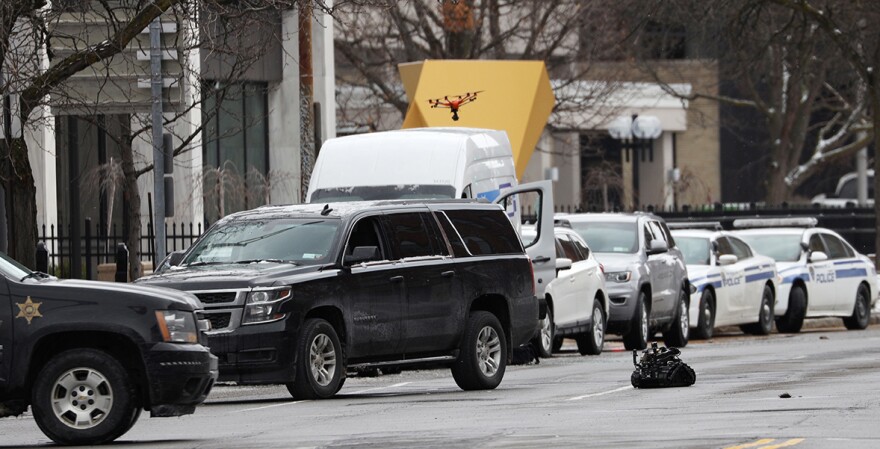Drones soon could be deployed to assist Rochester police officers in real time — from responding to reports of gunfire to tracking a fleeing suspect.
The initial 30-day pilot program being proposed is a small step toward adopting a larger drone program, as well as rethinking how drones are used in the department. RPD has thus far utilized drones in a limited capacity to fly over and monitor mass gatherings, including festivals, protests and sporting events.
“We have a unit that operates some drones within our department, so now what we're looking at is the possibility of expanding that,” said RPD Capt. Greg Bello. “If it comes to it, we’re exploring the possibility, not saying that we are doing it or not doing it.”
The pilot would use drones to provide real-time video and assist in “crime scenes, vehicle accidents, field intelligence, officer safety data, suspect movement, and industrial incidents,” according to the proposal.
Officers would still respond to every call in-person, Bello said, but the drones could provide a layout of the scene before their arrival.
The expanded effort would use $25,000 in federal forfeiture funds, or assets seized in criminal investigations. The pilot would not involve buying any new equipment, and the funding would mostly support overtime expenses for the department’s Special Investigation Section, which houses the existing drone program at the department’s North Clinton Avenue section office.
Drones as first responder programs intend to create networks of drones to provide police with real-time information before they arrive on scenes. It also has become a cottage tech industry in recent years.
Bello said the department has received presentations already from two contractors promoting drones as first responders programs. He declined to name the contractors or provide a specific price tag for their drone packages, but said it was “millions and millions of dollars.”
The largest player in the drone as first responder industry is Skydio, a relatively new start-up which entered the military and police drone industry in August 2023. It has since become one of the go-to providers of drone systems to police departments. The New York City Police Department, for example, contracted with Skydio and launched its drones as first responder program in November.
That program uses the company’s drones, which can be activated remotely and fly autonomously to reported robberies, gunshots, and thefts.
“New York City is flying into the future as we keep New Yorkers safe,” New York City Mayor Eric Adams said in a statement.
Schenectady also has adopted a drones as first responder program in late 2023, signing a $695,000 contract with BRINC, a competitor of Skydio. And Syracuse is in the process of also adopting a drone first responder program with an estimated price tag of $250,000.
Bello emphasized that the drones would be used only to respond to individual calls for service and would not be used for general surveillance. Whether that means contracting with an outside firm or building a robust drone system internally will be assessed at the conclusion of the pilot.
“We haven't used our drones in this way before, so it's a chance for us to get out there and see the benefit of it and see, is this something that our drone team is able to do or is this something we would need to go external for,” Bello said.
The increasingly heavy use of drones by police departments nationwide has drawn scrutiny from civil rights organizations.
On Tuesday, the New York Civil Liberties Union released a report questioning the use of drones as first responders. Dubbed “Prying Eyes,” the report questions the value of drones as crime-fighting tools.
“There is no evidence drones provide meaningful benefits or work well as first responders,” the report reads. “Drones are first and foremost a surveillance technology — so using them always raises significant constitutional concerns — but there is also the danger that utilizing drones will shift funding away from in-person, human responders, or other supportive programs that are better equipped to keep people safe.”
The report offers data on the number of registered drones used by police departments across New York. The Monroe County Sheriff’s Office leads the pack locally, with 23 registered drones in 2024. Police departments in Greece, Penfield, Webster, and Hilton also showed registered drones.
New York State Police have the state’s highest number of registered drones, at 124, followed by the NYPD at 99.
Others raising objections include the New York City-based advocacy group the Surveillance Technology Oversight Project (STOP).
“One of the things I find most baffling about this is that when people call 911 for a medical emergency or a fire, a drone can watch those tragedies unfold, but it can't actually do anything to stop them,” executive director Albert Fox Cahn said in a telephone interview.
Cahn said STOP is particularly concerned that drones could pose a threat to rights to privacy.
“Aerial surveillance always raises issues, but when that camera is hovering just a few feet above your property line or just outside your bedroom window, it's a very different set of concerns,” Cahn said, adding: “The closer these surveillance drones get to your home, the more intimately they can peer inside.”
The Rochester City Council is set to vote on funding for the pilot program on April 29. Bello said the 30-day run is meant to answer a simple question.
“How useful is it to us?” Bello said. “Does it end up being an afterthought on calls and really not worth it, or does it end up being this huge saving grace for us?”



